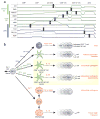Re(de)fining the dendritic cell lineage
- PMID: 23160217
- PMCID: PMC3644874
- DOI: 10.1038/ni.2467
Re(de)fining the dendritic cell lineage
Erratum in
- Nat Immunol. 2013 Apr;14(4):413
Abstract
Dendritic cells (DCs) are essential mediators of innate and adaptive immune responses. Study of these critical cells has been complicated by their similarity to other hematopoietic lineages, particularly monocytes and macrophages. Progress has been made in three critical areas of DC biology: the characterization of lineage-restricted progenitors in the bone marrow, the identification of cytokines and transcription factors required during differentiation, and the development of genetic tools for the visualization and depletion of DCs in vivo. Collectively, these advances have clarified the nature of the DC lineage and have provided novel insights into their function during health and disease.
Conflict of interest statement
The authors have no conflicting financial interests.
Figures




Similar articles
-
Zbtb46 expression distinguishes classical dendritic cells and their committed progenitors from other immune lineages.J Exp Med. 2012 Jun 4;209(6):1135-52. doi: 10.1084/jem.20120030. Epub 2012 May 21. J Exp Med. 2012. PMID: 22615127 Free PMC article.
-
Dendritic cell subsets and lineages, and their functions in innate and adaptive immunity.Cell. 2001 Aug 10;106(3):259-62. doi: 10.1016/s0092-8674(01)00456-1. Cell. 2001. PMID: 11509173 Review. No abstract available.
-
A common pathway for dendritic cell and early B cell development.J Immunol. 2001 Aug 1;167(3):1387-92. doi: 10.4049/jimmunol.167.3.1387. J Immunol. 2001. PMID: 11466357
-
Epigenetic control of Ccr7 expression in distinct lineages of lung dendritic cells.J Immunol. 2014 Nov 15;193(10):4904-13. doi: 10.4049/jimmunol.1401104. Epub 2014 Oct 8. J Immunol. 2014. PMID: 25297875 Free PMC article.
-
Transcription factor networks in dendritic cell development.Semin Immunol. 2011 Oct;23(5):388-97. doi: 10.1016/j.smim.2011.08.009. Epub 2011 Sep 15. Semin Immunol. 2011. PMID: 21924924 Free PMC article. Review.
Cited by
-
A Plasmacytoid Dendritic Cells-Type I Interferon Axis Is Critically Implicated in the Pathogenesis of Systemic Lupus Erythematosus.Int J Mol Sci. 2015 Jun 23;16(6):14158-70. doi: 10.3390/ijms160614158. Int J Mol Sci. 2015. PMID: 26110387 Free PMC article. Review.
-
Bcl11b sets pro-T cell fate by site-specific cofactor recruitment and by repressing Id2 and Zbtb16.Nat Immunol. 2018 Dec;19(12):1427-1440. doi: 10.1038/s41590-018-0238-4. Epub 2018 Oct 30. Nat Immunol. 2018. PMID: 30374131 Free PMC article.
-
Regulatory Networks Involving STATs, IRFs, and NFκB in Inflammation.Front Immunol. 2018 Nov 13;9:2542. doi: 10.3389/fimmu.2018.02542. eCollection 2018. Front Immunol. 2018. PMID: 30483250 Free PMC article. Review.
-
Dendritic Cells and Their Immunotherapeutic Potential for Treating Type 1 Diabetes.Int J Mol Sci. 2022 Apr 28;23(9):4885. doi: 10.3390/ijms23094885. Int J Mol Sci. 2022. PMID: 35563276 Free PMC article. Review.
-
ZBTB46 defines and regulates ILC3s that protect the intestine.Nature. 2022 Sep;609(7925):159-165. doi: 10.1038/s41586-022-04934-4. Epub 2022 Jul 13. Nature. 2022. PMID: 35831503 Free PMC article.
References
-
- Xie H, et al. Stepwise reprogramming of B cells into macrophages. Cell. 2004;117:663–676. - PubMed
-
- Pui JC, et al. Notch1 expression in early lymphopoiesis influences B versus T lineage determination. Immunity. 1999;11:299–308. - PubMed
-
- Radtke F, et al. Deficient T cell fate specification in mice with an induced inactivation of Notch1. Immunity. 1999;10:547–558. - PubMed
-
- Steinman RM. Decisions About Dendritic Cells: Past, Present, and Future. Annu Rev Immunol. 2011;30:1–22. - PubMed
Publication types
MeSH terms
Substances
Grants and funding
LinkOut - more resources
Full Text Sources
Other Literature Sources

